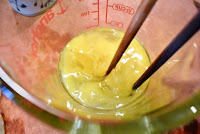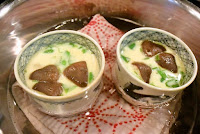Heavenly soft custard that quickly disappears on your tongue after releasing its umami-packed flavor. When serving only a small number of people, chawanmushi is easy to make in a regular pot or deeper pan with lid. Finishing with a smooth surface and no obvious holes is the sign of extra silky texture; for this, cook at low heat once water starts to bubble and the pot is filled with steam! While all solid ingredients can be immersed in the egg-dashi mixture, shrimp is placed after custard has basically solidified so that it stays on top along with mitsuba leaves and yuzu peel, the aromatic garnishes.
1/2 of recipe:
66 calories; 7.7 g protein; 2.7 g fat; 2.2 g carbohydrate; 1.8 g net carbs; 210 mg sodium; 125 mg cholesterol; 0.4 g fiber
1 egg
160 cc dashi
1/2 tsp usukuchi pale soy sauce
1/4 tsp shiokoji
Solid ingredients and topping
2 shrimp (39 g with heads and shells in photo; 20 g after shelling)
1 sea scallops (25 g in photo)
1 shiitake mushroom (umbrella part only, 9 g in photo)
Several yurine lily bulb pieces (rehydrated dry yurine, 6 g in photo)
Tiny handful mitsuba (1 g in photo)
<Directions >
1.
Cut shiitake into several sections.
Chop scallops in a size to match shiitake.
Shell and devein (without cutting) shrimp.
Chop mitsuba, except for some leaves for topping.
2.
In each cup for steaming, place solid ingredients except for shrimp, mitsuba and yuzu peel for topping.
3.
In a cup or bowl, break egg, and mix by moving chopsticks sideways (aim to cut apart egg white; do not whip or incorporate air).
Pour dashi, usukuchi soy sauce and shiokoji into egg, and mix (do not whip or incorporate air).
Egg-dashi mixture is ready.
3.
Pour egg-dashi mixture into each cup through tea strainer.
4.
Place cups in a pot lined with cloth or paper towels.
Pour water to one-third or half of cups' height, and place lid covered with a cloth.
Cook, first at high or medium high heat until water bubbles and steam fills pot, then reduce heat to low or very low.
5.
Five or six minutes after reducing heat to low, check inside.
Gently move pan sideways, and if custard surface basically seems solid (no obvious liquid part in center), place shrimp on top.
Cover again, and steam for another 2-3 minutes.
Remove from heat, and wait a few more minutes (keep covered).
(Sneak peek after 2 minutes)
6.
Meanwhile, obtain two slices of yuzu peel.
7.
Top each cup with mitsuba leaves and yuzu peel.
Ready to serve.
<Notes>
- When mixing dashi and egg, dashi needs to be cooler than 60C/140F to prevent solidifying the egg. If your dashi is hot, wait until it cools.
- Shiitake can be thinly sliced instead of chopped.
- Yuzu peel is optional but highly recommended if available.
- Wrapping lid with a cloth is to prevent water dripping onto custard while steaming.
- Other common ingredients include chicken, ginnan gingko nuts and kamaboko fishcake. If adding chicken, season with a tiny amount of soy sauce after chopping. If adding kamaboko, quickly boil to desalinate if you are on a reduced-sodium diet.
- While mushrooms are popular additions, among which shiitake is the most common, maitake (hen of the woods) is usually avoided because it is said to contain an enzyme that prevents eggs from solidifying.
- When udon wheat noodles are added as a main ingredient, the dish is called Odamakimushi.
- Egg and dashi proportion is usually 1 to 3-4 by weight (1 egg weighs about 50-55 g, therefore 1 egg and 150-200 g/cc dashi). For this amount, 1 tsp soy sauce (usually usukuchi type due to its pale color) is standard. In the recipe above, I stick to usukuchi but use only half the amount, supplementing it with shiokoji, which also provides enough sweetness.

















No comments:
Post a Comment